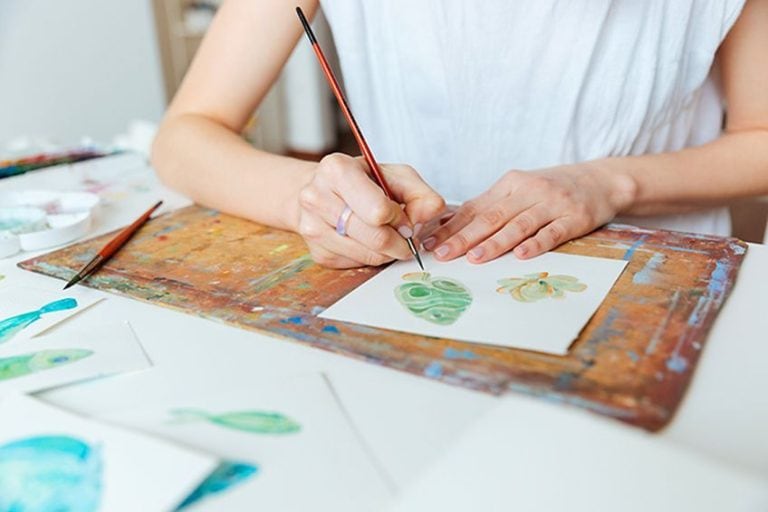How to Paint a Watercolor Beach – Seascape Painting Lesson
Learning how to paint a watercolor beach is such a fun activity. What is so great about learning how to paint a watercolor beach is that you are simultaneously learning how to draw an ocean as well as various other things that make up the beach watercolor painting. Beach scenery painting allows you to gain a little bit of confidence in your landscape painting repertoire. This can be helpful when painting other landscapes as you will learn a few tips and tricks during this beach watercolor painting.
Table of Contents
- 1 An Easy Guide to Painting a Watercolor Beach
- 2 Step-by-Step Instructions on How to Paint a Watercolor Beach
- 2.1 Step 1: Making the Sky
- 2.2 Step 2: Painting the Lightest Layer of the Beach
- 2.3 Step 3: Painting Grass on the Beach
- 2.4 Step 4: Painting the First layer of the Ocean
- 2.5 Step 5: Painting the Second layer of the Beach
- 2.6 Step 6: Slowly Adding More Layers to the Beach and Ocean
- 2.7 Step 7: Adding Final Details
- 3 Tips to Remember
- 4 Frequently Asked Questions
An Easy Guide to Painting a Watercolor Beach
Learning how to paint a watercolor beach comes with three distinct features: the sky, the ocean, and the beach. As we go through this tutorial, we will break down the different ways in which we understand the different watercolor beach scenes. Beach scenery painting can be produced in various ways with different themes. However, in this tutorial, we will be painting a beach during a sunset setting which will give the painting a unique and interesting feel. With that said, let us see what materials we will need:

Necessary Materials
As we paint the watercolor beach scenes, such as the sky, sand, and ocean, we want to have the correct materials on hand. Starting with the correct paper, preferably anything that is 300GSM in thickness. We also want to have the correct paintbrushes so try to get yourself some watercolor paintbrushes. We want to also make sure that we have the correct watercolor paints, pan paints are perfect for this tutorial. Lastly, we want to tape our paper down to the surface that we will be working on. So, the last thing we will need is some scotch tape.
Preparation
Now that we have all the correct materials let us begin to prepare ourselves for this tutorial. We want to place ourselves in a nice environment as we learn how to paint a watercolor beach. Learning how to paint a watercolor beach requires a bit of focus as each watercolor beach scene will take some time and attention. So, try to place yourself in a quiet environment.
Lastly, make sure you have two jars of water nearby for rinsing and cleaning your brushes. With that said let us get into this tutorial on how to paint a watercolor beach.
Step-by-Step Instructions on How to Paint a Watercolor Beach
In this tutorial, we will learn a few tips and tricks on how to paint a watercolor beach. We begin the beach scenery painting by creating a sky. As we paint the sky this will start to contextualize the landscape. As we paint the beach itself, we will see how there are variations in the color of the sand that will create texture and shadow in our beach watercolor painting. Beach scenery painting should also be accompanied by interesting details, which is why we will also give some shrubbery to our beach scene. Learning how to draw the ocean or how to paint water is the same. It’s simply about creating various horizontal strokes with different-sized brushes. When creating a watercolor beach scene, we must add the ocean to the painting which will separate the sky from the beach. With that said let us get started.

Step 1: Making the Sky
When painting a beach, the first thing we want to do is make the sky. Painting the sky is quite simple, we begin by taping a strip of scotch tape across the page in a horizontal direction. We want the tape to be pasted slightly above the center of the page. This gives a nice ratio between sky, sea, and land. Once that is done, we can coat the top section of our page with a thin layer of water.

We will now proceed with the tutorial and begin to paint the sky with various colors on the wet surface. What you want to do is always start with the lightest colors. Starting with yellow, begin to make strokes that form from the left of the page. We want to create a section where we will paint the sun. The clouds should seem as if they are moving outwardly from this section.

When painting skies, you will realize that you can paint clouds in various directions. This is because skies all look differently, meaning that clouds move in all sorts of directions. Allow yourself to be playful with your marks. They can move in all different directions. However, we want to add paint onto the page fast, whilst the page is still wet.
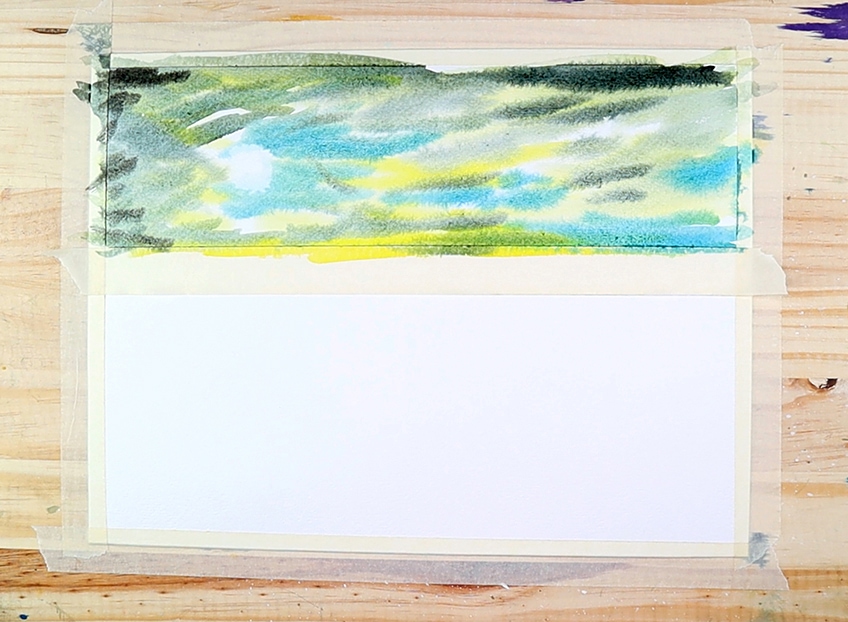
We can now start integrating various colors into the sky. This means we can add various colors onto the wet surface so that once they dry, they will dry evenly as the wet page dries all the colors together. This is why we want to add colors onto the web page as quickly as possible so that the colors can dry together.

Again, skies are all different which means that sunsets can create various colors that reflect in the clouds. However, we want to contextualize the sky with the sun by taking some tissue paper and dabbing a little circle on the wet surface. This is going to leave a little negative space in the shape of a circle that will function as the sun in the sky.

Once we are satisfied with our sky, we will then allow it to dry completely. We should be left with a sky that depicts a beautiful array of colors. Remember, to have long strokes in your sky, a good suggestion is to make sure that you paint them out of the frame of the page, creating a sense of vastness.

Another good suggestion is to make the strokes short and thin near the sun, this will help create a sense of depth. Once your sky has completely dried, you can now remove the scotch tape from the page. What we should be left with is a clean horizon line produced by the scotch tape.
The horizon line needs to be straight; this gives a more realistic impression to the painting. Allowing for the sea to have a sense of distance once painted.
Step 2: Painting the Lightest Layer of the Beach
We will now begin to paint the beach by drawing a diagonal line starting about four centimeters under the horizon line. We want to draw this line across the page, moving from the left of the page in a downward direction to the right of the page. We then want to coat the bottom section of the page, under the pencil line, with a thin coat of water.

We will proceed to paint the beach with a light tan color, which you can make with a mix of yellow and brown paint. We want to paint strokes in this section of the page without covering the whole section in this tan color. We do, however, want to make sure that we make strokes in this section of the page covering most of it as this color will serve as the lightest tone of the beach.

Whilst the page is still wet, we can darken our mix of tan to create a darker brown. We do this by adding hints of dark brown into the mix with little hints of black paint. We do this because we want to create shadow and texture in the sand. We can proceed to make horizontal strokes in the sand with this darker brown.

With watercolor the colors will dry much lighter than how they seem on the page whilst wet, so don’t worry too much if the color seems to be dark while it is wet. We want to make sure that the lightest tan color is added first with horizontal strokes of a slightly darker brown. Make these darker strokes spread out.

Step 3: Painting Grass on the Beach
In this beach painting, we will add a little detail to the scene by painting some grassy areas on the beach sand. We do this by making a slightly darker tone of brown by adding a ratio with more brown and black hints of paint mixed with yellow. We want to get a relatively dark brown color. We can create a bush in the foreground and a bush in the middle ground. We want to add this first layer whilst the paint is still wet.

The shrubbery is going to create interesting moments of shadow on the beach. This scene is also depicted during sunset which means that from the perspective we are viewing the scene, the grass will be dark. This means that the shadows will be directed towards the viewer. This is why we want these moments to be dark. Because we are painting the shrubbery in the midground and foreground the social of both plants will be different in scale. The one on the right will stem from the outside of the frame, whereas the one in the foreground will be planted in the sand.
With the one that is in the foreground, we want to make strokes from the outside of the frame.
Step 4: Painting the First layer of the Ocean
Whilst the first layer of the beach is still drying, we want to move onto the ocean part of the painting. We should have an open middle section on our page, which we will proceed to coat with a thin layer of water. This is where we are going to paint the sea. Proceed to make a mix of blue with a hint of black. Then we will proceed to make horizontal strokes in this vicinity of the page onto the wet surface.

As we make these strokes we want to work with a thin and a thick brush. We want to make thicker horizontal strokes closer towards the beach. However, we want to make thinner strokes near the part that is closer to the sky. This is going to create the quality of depth.

As you carry on painting these strokes allow some negative space to form directly under the sun. We want some of the white pages to be present through the strokes that fall directly under the sun. This is going to create a reflection in the water, giving the painting a more realistic quality of light interacting with the surface of the water.

Step 5: Painting the Second layer of the Beach
Let us move on to painting the second layer of the beach, which should be completely dry at this point. As we proceed to paint the second layer of the beach, we want to give it a light wash of water with a clean brush. We then will proceed to make some dark brown horizontal strokes on the beach section.

Allow yourself to also play around with various browns in your beach scene. We have established the foundational color in the first layer, so adding more layers with different color tonal values can add dimension to the sand. You can also play around with the scale of the strokes. You can also add more strokes to your bushes.
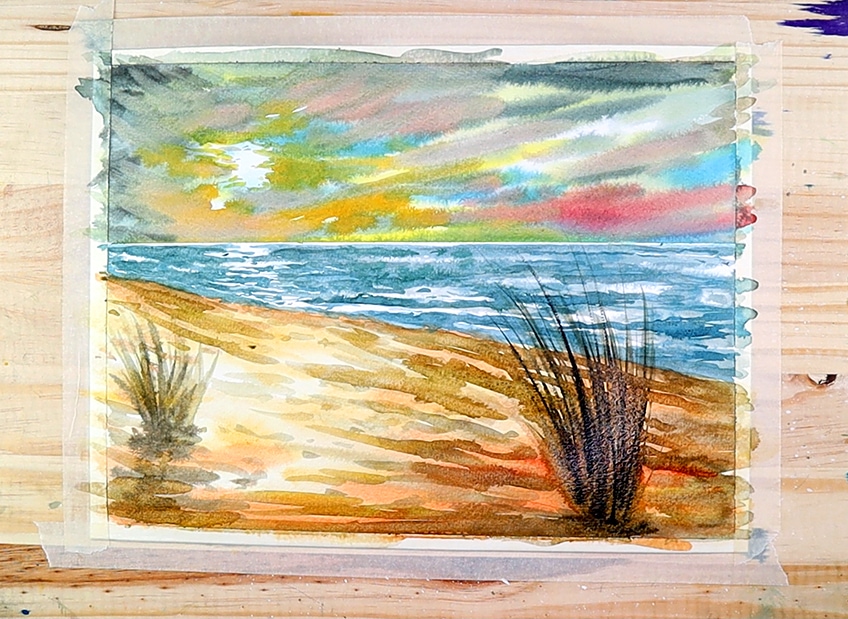
By adding more layers to the beach and the grass we are slowly giving them more dimension. Whilst the surface is slightly wet you can add darker tonal values to the grass. Remember, we are seeing the shadowed part of the grass, this means that the grass will be quite dark from this perspective. We can also add little hints of light green in these strokes for the grass to give moments of light catching the grass.
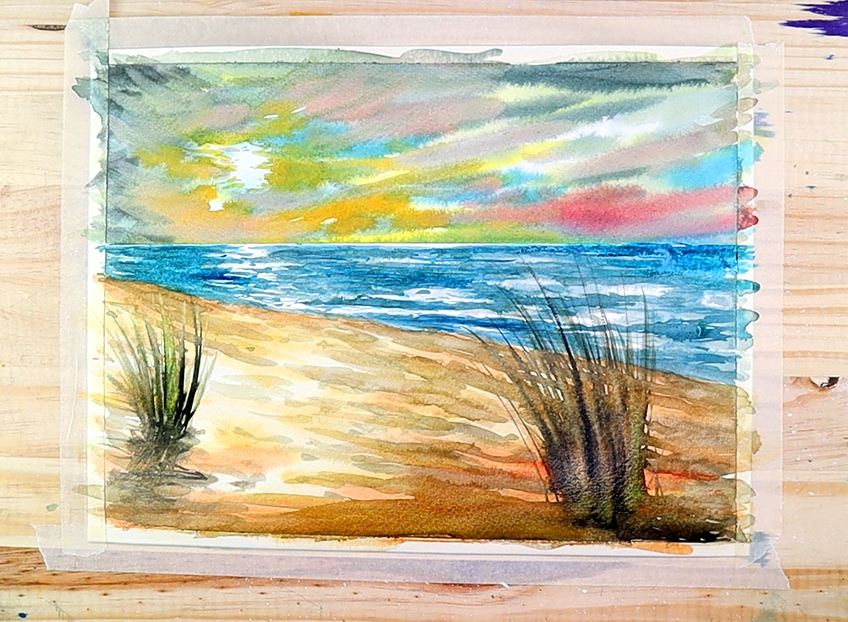
Step 6: Slowly Adding More Layers to the Beach and Ocean
What we are doing is slowly bouncing back and forth between the ocean and the beach segments of the landscape. The aim is to work on each part once it has dried completely. As the beach segment slowly dries, we can add some darker horizontal strokes in the ocean. Try to be sparing with these darker strokes.
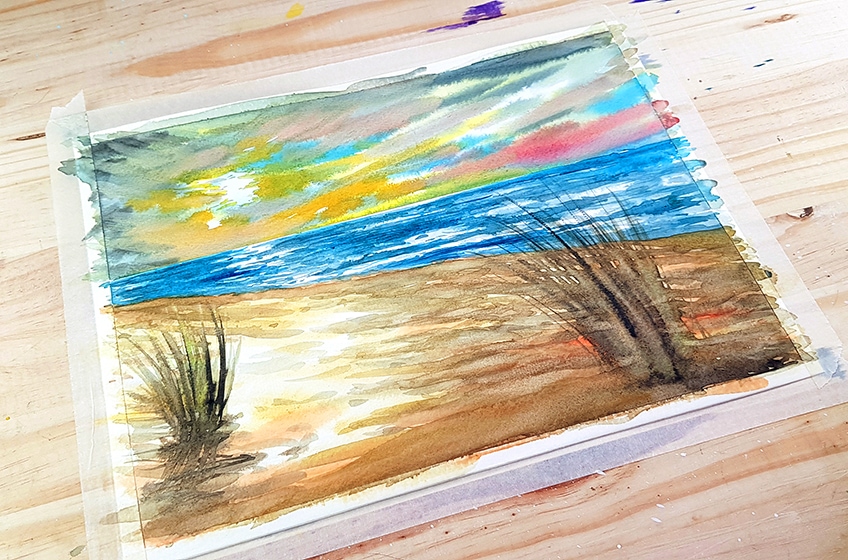
Once those marks are completely dry, we can move back to the beach adding more darker marks to the grass sections. Again, we want to pay attention to the sun as a direction of light. This means we want to keep a strip of light moments that run directly under the sun. We can do this both in the ocean and beach segments.

We can also add more qualities to the beach scene by covering the ocean and sky portion with some paper. We then take a brush with brown paint and begin to make small splatter marks that give the beach scene a little more texture.

Again, we just want to slowly work in more detail for both the ocean and the beach segment. This means that we add little bits of detail as each section dries. For the ocean, we can add slightly darker blue strokes each time. For the beach, we can darken the bushes, as well as the shadows that they cast
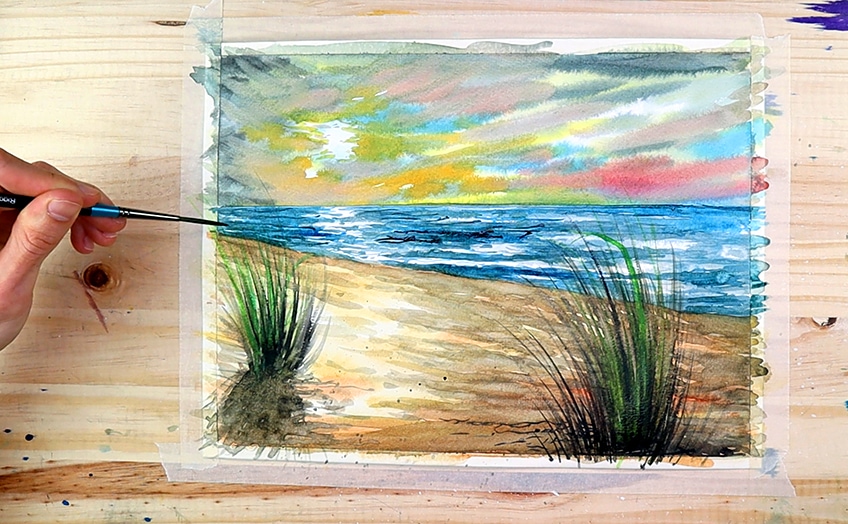
Again, as you add strokes to the ocean segment try to make smaller strokes near the horizon and larger strokes near the beach. For the beach play around with little splatters to create a grainy quality, as well as add more strokes to your grass sections.
A good suggestion is to also add hints of light green strokes for the grass.
Step 7: Adding Final Details
Again, as you make strokes in the ocean section remember to leave negative space where the reflection of the sun would fall on the water. The same goes for the beach, leaving a section directly under the sun slightly lighter as the sand reflects light as well. Otherwise, you can add more details that you feel may enhance the quality of the painting.

Allow your work to completely dry, and there you have it! A simple guide to painting a beach at sunset. This tutorial gives you general instructions on how to paint a beach scene from the sky to the ocean to the sand. Beach scenery painting is a really fun task, but it does take some practice. As you do your beach watercolor painting add little bits that you feel might give it a more complete feel.
Tips to Remember
There are many ways to paint a beach, however, this tutorial is directed towards a sunset scene over the beach. Depending on what kind of time setting you are trying to create, painting a beach will always have the component of the sky. This gives us a lot of freedom to contextualize the scene simply by how we paint the sky. Here are some additional watercolor painting tips and tricks.
- Try to take breaks whilst you wait for your painting to dry, this can be helpful for the process.
- Painting skies can be done in various ways, so remember to be playful with your color choices as you paint the sky
- As you paint the scene remember to always have two jars of water nearby for cleaning your brushes.

- Take your time, remember that painting is a practiced skill. So don’t worry about perfecting it the first time.
- When making the sun by dabbing the paint with tissue try to be quick about it so that you get the sun as white as possible.
- Ultimately, try to have fun. Painting is fun when we feel relaxed and not under pressure. So, take your time, listen to some music and enjoy the process.
As we paint the beach sand, we can see that there are a few mixes of various browns that come into play. This gives the scene a little more nuance and detail, ultimately making the scene more interesting. We also see that painting an ocean scene is also essential to completing the beach scene. Painting water is not difficult, it is simply a matter of knowing how to integrate various horizontal strokes. This creates the quality of waves which ultimately defines the wavy quality of the ocean.
Frequently Asked Questions
How Do You Paint a Sky?
Painting skies can be achieved in many ways. However, a key component that contextualizes a sky is often the clouds. In this tutorial we see how making a sun, with negative space on the page, in conjunction with different colors moving in various directions can describe a colorful sky or sunset. When we paint skies that are in the midday without any clouds then it is more a matter of the landscape itself that will contextualize the sky like a sky. However, painting skies with clouds is much more fun and it interestingly details the sky. As you learn how to paint clouds there are a few techniques that you can use. In this tutorial, we go through the process of colors and strokes. Looking at how these two components describe a beautiful sunset in the sky.
How Do You Paint Light Reflection on Water With Watercolor?
Painting light reflections is quite a simple task which is often achieved by using negative spaces on the page. This means that we do not necessarily paint light reflections, rather, what we are doing is painting water around negative space. This makes the white page work as a light reflection on the surface of the water. We achieve this quality in the water by making horizontal strokes of blue that function as the color of our water. These little horizontal strokes will work along a plain where they will move into the negative space but not completely cover the space with blue paint. Allowing for little moments of the white page to peer through the strokes of paint which will represent a reflection of light on the surface of the water.
How to Paint the Color of Sand in Watercolor?
Painting the sand color with watercolor is quite simple. This is because the color of sand varies according to shadows that may fall on the beach. This means that we want to be quite broad with our color choice when painting sand. However, we do want the dominant color tone to be that of a light tan brown, which we can either achieve by making a mix of browns with yellows to lighten the brown or in some cases most watercolor pan sets come with a light tan brown which you can lighten further with hints of yellow. However, as you paint the sand of a beach you want to create various movements in the sand, which we can achieve with darker tones of brown.
Matthew Matthysen is an educated multidisciplinary artist and illustrator. He successfully completed his art degree at the University of Witwatersrand in South Africa, majoring in art history and contemporary drawing. The focus of his thesis was to explore the philosophical implications of the macro and micro-universe on the human experience. Matthew uses diverse media, such as written and hands-on components, to explore various approaches that are on the border between philosophy and science.
Matthew organized various exhibitions before and during his years as a student and is still passionate about doing so today. He currently works as a freelance artist and writer in various fields. He also has a permanent position at a renowned online gallery (ArtGazette) where he produces various works on commission. As a freelance artist, he creates several series and successfully sells them to galleries and collectors. He loves to use his work and skills in various fields of interest.
Matthew has been creating drawing and painting tutorials since the relaunch in 2020. Through his involvement with artincontext.org, he has been able to deepen his knowledge of various painting mediums. For example, watercolor techniques, calligraphy and lately digital drawing, which is becoming more and more popular.
Learn more about Matthew Matthysen and the Art in Context Team.
Cite this Article
Matthew, Matthysen, “How to Paint a Watercolor Beach – Seascape Painting Lesson.” Art in Context. February 17, 2022. URL: https://artincontext.org/how-to-paint-a-watercolor-beach/
Matthysen, M. (2022, 17 February). How to Paint a Watercolor Beach – Seascape Painting Lesson. Art in Context. https://artincontext.org/how-to-paint-a-watercolor-beach/
Matthysen, Matthew. “How to Paint a Watercolor Beach – Seascape Painting Lesson.” Art in Context, February 17, 2022. https://artincontext.org/how-to-paint-a-watercolor-beach/.








